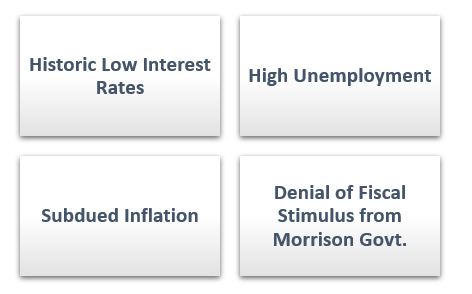Just a week after the Reserve Bank of Australia (RBA) slashed the interest rates by 25 basis points, the RBA governor Philip Lowe has published a report underlining the effects of the unconventional policy tools like negative interest rates and quantitative easing.
The report published by Mr Lowe was titled ?Unconventional monetary policy tools: a cross-country analysis?.
Mr Lowe recognized the net positives of the unconventional instruments and signaled that Australia could also face unconventional policy measures to revive the economy. He also hinted over an extended period of low interest rates and engagement in more unconventional policies for the growth of the economy.
According to the Governor, the central banks cannot take out economies out of trouble without the support of fiscal policies. He noted that the monetary policy tools are most effective when combined with fiscal and prudential measures.
Key Highlights of BIS Report
The report has been compiled by Bank for International Settlements or BIS and overseen by the RBA Governor. BIS reviewed four tools used by the central banks across the world since the 2008 global financial crisis (GFC), including new central bank lending operations, negative interest rate policies, forward guidance and asset purchase programmes.
The report contained the details of the unconventional monetary policy tools that have been adopted by central banks to deal with the GFC and its aftermath.
The report highlighted the following points:
- Unconventional monetary policy tools have helped central banks address the circumstances presented by the global financial crisis and the resulting economic downturns.
- Despite the challenges posed by the unconventional monetary policy instruments, they add value to the central banking toolbox.
- Effectiveness of these instruments is enhanced when they are deployed in connection to a strategy that covers other types of public policy, along with monetary policy, in order to alleviate their side effects and boost their value.
- The comparison of the conventional and unconventional monetary policy tools demonstrated that many of the tools had already been used by the central banks in the past (prior to GFC). However, the broad use of unconventional monetary policy tools and the scale of their deployment post the GFC make them different.
- Unconventional tools offer policymakers additional flexibility and policy space, efficiently tackling the GFC?s most destructive consequences and assisting central banks to carry out the accomplishment of their mandates when conventional policy get restricted.
- Overall, the negative interest rate policies were seen effective in dealing with effective lower bound or ELB events such as long-term yields adjusted downwards in accordance with expectations of future short-term rates, thus supplying the required expansionary stimulus.
- The possible longer-term effects of a persistent period of negative rates on financial intermediaries cannot be fully measured based on the existing experience.
- Forward Guidance played an indispensable role in a period of heightened uncertainty about the ability of central banks to deal with the challenges and the economic outlook.
- The use of unconventional tools by the central banks across the world, would be more useful if other policy agencies are ready to deal promptly with financial vulnerabilities as soon as they occur, lowering the risk that the unconventional tools will be required in the first place.
Will RBA Go for Unconventional Tools?
Some economists expect the RBA to consider employing unconventional monetary policy tools probably by next year. The economists at the National Australia Bank (NAB) also predicted the implementation of quantitative easing later next year unless the Coalition government resorts to fiscal stimulus. However, the RBA recently told a parliamentary committee that it is highly unlikely for the bank to adopt quantitative easing at this stage.
Central banks usually go for unconventional measures when they appeared to run up against the limits of what they could achieve with conventional tools. Even at the time of the GFC, the financial conditions did not respond sufficiently to reductions in policy rates at first, and conventional policy easing ran into the constraints of the effective lower bound. This induced the central banks to adopt unconventional monetary policy tools that targeted something other than short-term interest rates.
Let us discuss the key possible reasons that might induce the RBA to go for unconventional policy measures below:
Historic Low Interest Rates
The RBA has already lowered the interest rates to a historic low level of 0.75 per cent recently. Though the interest rate cut was in line with the market expectations, it highlighted the challenging state of Australia?s economy. As per some economists, the recent rate cut leaves the RBA just 25 basis points away from the position it has previously indicated where it could adopt unconventional policy measures. In August, the RBA?s deputy governor Guy Debelle raised the possibility of about zero interest rate level in the Australian economy.
High Unemployment
Despite the recent rate cut moves by the RBA, the unemployment rate soared to 5.3 per cent in August. Though the country experienced a growth in employment, the unemployment rate remained high, signaling the slow pace of job creation in the economy. Post the release of August?s unemployment figures, the speculations of total four rate cuts by the end of this year got increased.
Subdued Inflation
The inflation in Australia is prevailing below its target range of 2-3 per cent for quite a long time. The inflation has remained subdued, being at 1.6 per cent in the June 2019 quarter. The central bank has eased the monetary policy thrice this year to lift inflation and help it reach the medium-term target.
Denial of Fiscal Stimulus from Morrison Govt.
The federal government is refusing pressure to inject stimulus into the Australian economy as the RBA moves towards reducing interest rates to about zero per cent level. Instead, the government has been putting pressure on the RBA to lower interest rates and pushing banks to pass on the full rate cuts to borrowers.
As per the Treasurer Josh Frydenberg, the slowdown in economic growth (1.4 per cent) that has been experienced by the country over the year to the June quarter 2019, does not fully reflect the effect of RBA rate cuts or the tax refunds that have been flowing into household accounts.
In addition to monetary policy measures, the RBA is eying for fiscal stimulus from the federal government amidst the current scenario. According to some economists, any further reduction in interest rates could result in negative consequences, and it would be very difficult to pull back from unconventional policies once the RBA starts adopting it.
Disclaimer
This website is a service of Kalkine Media Pty. Ltd. A.C.N. 629 651 672. The website has been prepared for informational purposes only and is not intended to be used as a complete source of information on any particular company. Kalkine Media does not in any way endorse or recommend individuals, products or services that may be discussed on this site. Our publications are NOT a solicitation or recommendation to buy, sell or hold. We are neither licensed nor qualified to provide investment advice.







